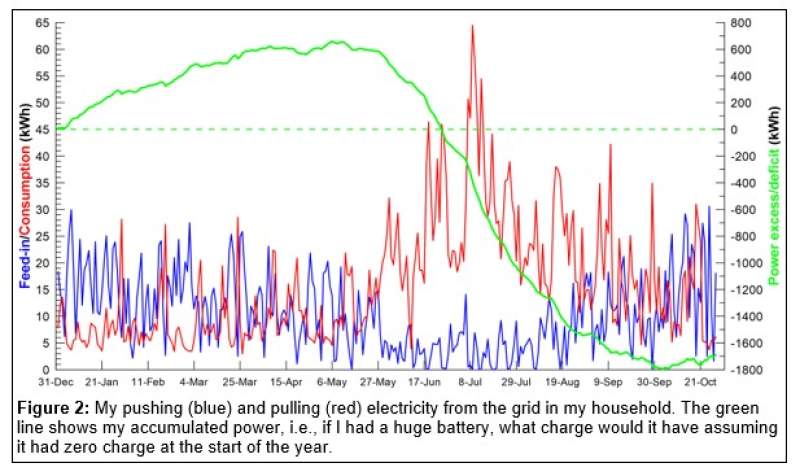“Nothing is more dangerous than an idea when it’s the only one we have” - Émile-Auguste Chartier
This quote springs to mind when I think of the Lake Onslow scheme. For those who may not know about the Lake Onslow scheme, the idea is to convert Lake Onslow, which sits in a shallow depression in the hills between Roxburgh and Middlemarch, into a giant battery. Importantly, Lake Onslow is around 685m above sea level while the Clutha River downstream from Roxburgh is at around 94m above sea level. That’s a 591m difference (see, those three years of maths at university are paying off). It means that when electricity is plentiful/cheap, a massive pump can be used to pump water out of the Clutha River and up into a much-expanded Lake Onslow. When electricity is scarce/expensive, water can be released from Lake Onslow down a pipe with a 591m drop in it, to generate electricity through a turbine – in the same way as is done in any hydroelectric power station. In this way, the Lake Onslow scheme, as a whole, acts like a giant battery. To be clear, the Lake Onslow scheme does not generate electricity in the same way that the Clyde dam does. If anything, it will increase the net burden on the national grid because inefficiencies in the system will result in a net consumption of electricity, just like any battery does, when averaged over a long period of operation. But it will be great at storing energy (in the form of the gravitational potential energy of the water raised into the lake) which can easily be converted into electricity.
I first heard about the Lake Onslow scheme from Earl Bardsley, the guy who came up with the idea, when he came to visit me around 2 years ago. I thought that it was a really interesting idea. I had some concerns about it though. The first is that it is not scalable. You either do it or you don’t, and if you decide to do it, you’re committed to a cost north of $4 billion. It is not like a ‘household’ scale scheme that can be deployed in each house and where you can start with a few houses and then see how it goes. You can’t ‘learn by doing’ where you use your experience from doing the first few installations to improve what you do on the next few. While I was also concerned that evaporative losses of the water in the high and windswept Lake Onslow would be a large loss of energy, it turns out that the evaporative losses are negligible.
First let’s be clear why we need something like the Lake Onslow scheme. The government’s goal is to have New Zealand’s electricity supply 100% renewable by 2030. This is an excellent goal. But it is extremely difficult to achieve this goal. It is way harder to make New Zealand’s electricity supply 100% renewable than 95% renewable. Consider 95% of the days in a year, i.e., around 347 days each year when there is enough water in the hydro dams, enough geothermal generation, and enough sun and/or wind somewhere around the country, for there to be enough renewable electricity supply to the national grid to meet the demand. But what about the remaining 18 days – those cold overcast winter days with not a breath of wind and, just to make matters worse, a dry 6 months prior such that the dams are worryingly low. Everyone comes home from the office, cranks up the heat pump, plugs in the EV, and gets dinner on the go. Electricity demand spikes. Then what? These are the times when Huntly needs to spin up quickly to meet the spike in demand. But Huntly burns coal and so cannot be a component of our 100% renewable electricity supply.
So, what are the alternatives? One is to design and build power stations that burn biomass, i.e., burn stuff that was grown on marginal land with the express purpose of burning it in a power station to create electricity. But I don’t want to go down that rabbit hole in this piece. I want to think about more ‘household’ scale solutions that are scalable and where we can learn as we go.
Around this time last year, I got solar panels put on the roof of my house. I had the option of including a lithium-ion battery with the system, but at around $1000/kWh of storage (so $15k for a 15kWh battery which is typical) I decided not to, waiting rather for the technology to come along that would allow me to connect the 40-kWh battery in my car to the house (still waiting).
I started thinking about other ways I could store electricity at home. My first thought was to get a drilling company to drill a 100m deep, 20cm diameter, borehole in my back yard. First some thoughts/questions:
1. Is this legal? Do I own the volume of the Earth below my property all the way to the centre of the Earth? If so, wow, that’s a lot of dirt I own. Maybe I should start a mine? I always was quite good at Minecraft. But I digress…
2. I need to make sure the dog (see Figure 1) doesn’t fall down the hole.
I would put an electric motor at the top of the hole to power a winch. At the end of the winch cable would be a 2m long lead weight weighing around 700kg. During the day, when I have excess electricity coming off the solar panels on my roof, the electric motor would lift that weight all the way from the bottom to the top of the hole. During the night, when I need electricity, the weight would slowly fall down the hole, running the electric motor in reverse as a generator (just like electric or hybrid vehicles do with regenerative braking) and pushing electricity back into the house. How much electricity can be stored in this way? It comes to a pitiful 0.193 kWh. I would need to drill 78 holes like that in my backyard to create the equivalent of a 15-kWh battery. The dog wouldn’t stand a chance.
I could use the excess electricity coming off the roof to electrolyse water into hydrogen (H2) and oxygen (O2), store the H2 and O2 in tanks buried in my back yard, and then when I need electricity, use the O2 and H2 in a fuel cell to generate electricity. But I am not sure how the CODC would feel about me storing large quantities of pressurized O2 and H2 (the stuff used to power the space shuttle) in tanks buried in my backyard. It could also make the neighbours nervous. And if those tanks did explode, it would be tickets for the dog and probably also the house.
A much safer option is a flow battery which stores the electricity as chemical energy – also a type of electrochemical cell where the chemical energy is provided by two chemical components dissolved in liquids. Their advantage is that they can store energy for a very long time, essential for carrying a household over the winter. This got me to thinking exactly what it would take to ‘carry my household over the winter’. Thanks to Meridian Energy’s wonderful web site, I can get the amount of electricity I have pushed to the grid and pulled from the grid over the course of this year. Have a look at Figure 2.

I suspect that my house is similar to most people’s houses, although with charging the EV at home I am likely to be pulling more electricity from the grid than most. But have a look at the green curve. This is very worrying. While I could be accumulating energy in a battery up until around early May, thereafter I start using more electricity than I can produce from the solar panels on the roof. By mid-winter my battery would be flat. To carry my household through the winter without having to pull any electricity from the grid, I would need to start the year with a fully charged battery of 1800 kWh! None of the ‘backyard’ options explored above will be sufficient. Neither will the piddly 40 kWh battery in my car. There is just no way that I can avoid burdening the national grid with current household scale battery technologies. That’s not to say that a battery wouldn’t be useful. A smart battery could be switched on when national demand peaks, avoiding that burden just during specific high-demand periods. I would be interested in seeing how many such smart batteries would need to be deployed in households around New Zealand to avoid having to build the Lake Onslow scheme.
In conclusion, storing energy, especially for the periods required to carry you over a long, cold and dry winter, is not easy. After my explorations detailed above, the Lake Onslow scheme appears increasingly attractive. Perhaps the corollary to Émile-Auguste Chartier’s saying is then “When you only have one idea, you can be 100% sure that it is your best idea”.
Related Stories
-

Extreme events and climate change
Consider the Paris Agreement where countries around the world have agreed to reduce greenhouse gas emissions with the goal of limiting global warming to well below 2°C, preferably to 1.5°C, compared to pre-industrial levels. Some people think “Who cares? It was 2°C warmer today than it was yesterday. 2°C is peanuts!”. Or consider sea-level rise. That could be around 3mm/year along the coast of Otago. That’s 3cm in a decade. Again peanuts, right? A wave could be 5 metres high so why are we worried about a 3cm rise over a decade?
Read more about Extreme events and climate change -

The Central Otago Destination Management Plan and Climate Change
CODC recently released its Destination Management Plan (DMP). I have read it and I think it’s excellent – and painful. Why painful? Because change is painful and this DMP highlights many changes to the way we do things that will be required. In this piece, I am going to share my thoughts on those aspects of the required changes articulated in the DMP that relate to climate change and are directly relevant to tourism services providers. Climate change poses an existential threat to some of the values that underpin the DMP, in particular Mauri - pressures imposed by land and water use are already being exacerbated by climate change and will be more so in the future.
Read more about The Central Otago Destination Management Plan and Climate Change -

Wood-burners and climate change
I often get asked about whether using wood-burners for interior heating contributes to climate change. For the purposes of this article, let’s set aside the effects that the use of wood-burners have on out-door air quality. Smoke from using wood-burners contributes to poor air quality; you only need to walk around Alexandra on a cold winter’s night with a strong inversion layer to notice that. But that’s mostly a different issue to climate change – I say ‘mostly’ because the aerosols (smoke) from wood-burners, if anything, make a small contribution to cooling the climate by reflecting solar radiation back to space before it reaches the ground.
Read more about Wood-burners and climate change





